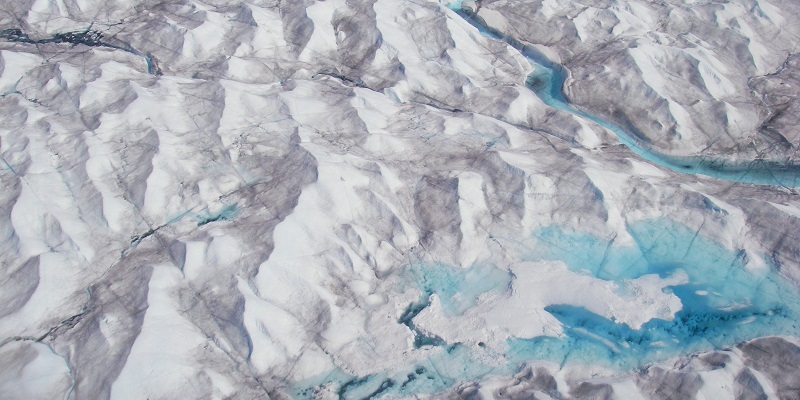Greenland ice flow likely to speed up

Seismic surveys challenge the view that recent slowdowns in Greenland’s ice flow will continue in the long term, says a new study published in Science Advances.
A team of scientists, including Dr Adam Booth from the University of Leeds, have carried out seismic surveys around a surface lake on the Greenland Ice Sheet. Their surveys found the ice sheet’s outlet glaciers slide over wet sediment, not hard rock as is widely assumed.
The research paper, “Seismic evidence for complex sedimentary control of Greenland Ice Sheet flow”, confirms that subglacial sediment played a key role in controlling ice sheet flow. The weakening of subglacial sediment leads to an accelerated ice flow as the subglacial environment becomes more slippery as global temperatures rise and meltwater supply becomes more variable.
Study co-author, Dr Booth from the School of Earth and Environment at Leeds contributed to seismic surveys in Greenland. He said: “We used to assume that Greenland’s glaciers were widely underlain by solid rock, but geophysical surveys are slowly revealing the extent and distribution of sediments down there.”
“Now that we know the glaciers are often slipping over wet sediment, it’s important to find out how widespread sediment is and how its properties change with meltwater supply. This is essential if we are to build up an accurate picture of future patterns of ice flow.”
Previous research identified two possible explanations for controlling the speed of the ice flow. The first, more widely-accepted, theory has been self-regulation, which proposes that glaciers slow down at the end of the summer because large networks of channels drain water away at the base, increasing frictional resistance to ice flow.
The second theory is to do with the soft sediments that recent research has shown beneath Greenland’s glaciers; in this model, changing patterns of water flow alternately weaken or strengthen the sediment, making it more or less slippery, and thus enhancing or decreasing the speed of ice flow.
Using seismic surveys to take measurements on the ice sheet, the team was able to test the sediment theory for the first time, challenging the accepted theory.
The seismic surveys were carried out around a surface lake on the Greenland Ice Sheet, where the ice is around 1.2 km thick. It involved using a series of controlled explosions to send acoustic waves through the glacier, which then bounce back to a series of small microphone-like sensors set up on the glacier.
Researcher Dr Adam Booth monitoring a controlled explosion (Credit C F Dow)
The seismic data are then analysed and characterise the physical properties of the sediment underneath the ice.
The research, published in Science Advances, was led by Professor Bernd Kulessa, a glaciologist at Swansea University, and involved experts from the UK, Canada, Sweden and Norway.
Professor Kulessa said: “Greenland’s margin has many outlet glaciers that act as fast conveyor belts of ice. Thousands of surface lakes act as taps that deliver meltwater to the ice base, turning it into a slippery bathtub.
“In a warming Arctic climate more ice will melt and make the sediments even sloppier and more slippery, so that fast ice flow can occur long into the future. This discovery leaves us concerned because we have so far accepted the exact opposite – that Greenland’s icy conveyor would slow down.”
The team included researchers from Swansea, Aberystwyth, Leeds and Cambridge universities in the UK, and from the Arctic University of Norway, the Norwegian Polar Institute, University of Waterloo (Canada) and Uppsala Universitet (Sweden).
Main image: Surface lake on the Greenland ice sheet; (Credit C F Dow)
